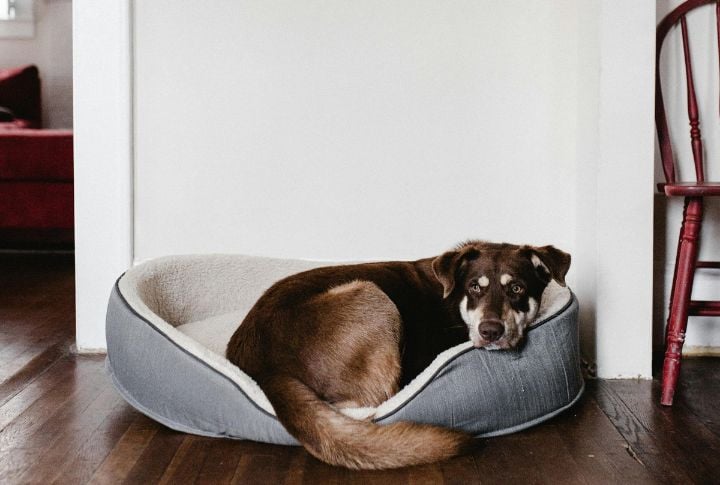15 Everyday Habits That Keep Older Dogs Going Strong

They no longer chase every squirrel or leap off the couch, but they still meet you at the door. Caring for a senior dog means noticing the details others miss. The slowed step and the quiet loyalty speak volumes. Let’s look at how to give them your best.
Schedule Regular Vet Visits

Dogs age faster than you think, and changes sneak up quickly. By age seven, many breeds benefit from twice-a-year wellness exams. Vets catch hidden problems like kidney shifts or silent arthritis. Skipping appointments can cause more stress later.
Adapt Their Diet As They Age

Due to changes in metabolism and muscle loss, elderly canines’ nutritional needs evolve. Senior formulas with added fiber, omega-3s, suitable vitamins, and lower fat content support joint health and weight control. Discuss specific bloodwork-based diet plans with your vet, as guesswork rarely benefits geriatric digestion or organ longevity.
Keep Their Mind Engaged

Mental workouts beat boredom fast. Hide treats in muffin tins and occasionally teach them a new paw trick. Keeping their brains active wards off cognitive decline and strengthens trust. A thinking dog is a happier, longer-present companion.
Provide Orthopedic Bedding

Orthopedic beds cushion pressure points and promote restful sleep. Stiff joints don’t appreciate cold tile floors. Memory foam helps distribute weight evenly, especially in large breeds prone to hip issues. Choose washable, low-profile models for easy access. Rest affects behavior and overall wellness.
Monitor Weight Closely

Old dogs don’t need a beach body, but carrying extra pounds wrecks their joints. That “just a few more bites” routine? Not doing them any favor. Fat is silent stress, so keep treats lean, and walk regularly. Arthritis won’t wait for New Year’s resolutions.
Maintain Consistent Routines

Change stresses older dogs. Keep meals, walks, games, and bedtime predictable. Familiarity helps reduce anxiety and supports healthy digestion. Skipping routines may seem harmless, but confusion builds quickly in aging dogs. Let their world stay steady even if their bodies aren’t. Stability isn’t just comfort; it’s clarity.
Prioritize Dental Health

That crooked smile once lit up every room, and now it hides behind swollen gums. Dental disease affects 80% of older dogs, but regular brushing and vet cleanings protect more than breath. Poor oral health leads to heart issues. Keep their grin healthy as long as possible.
Offer Joint Supplements Early

Clicking steps and slower rises start subtly. Glucosamine, chondroitin, and green-lipped mussel support worn cartilage. Early support matters, so don’t wait until they limp. Protect movement while they still run toward the door. Aging doesn’t mean surrendering mobility; it means defending it fiercely.
Watch for Behavioral Shifts

Sudden clinginess or withdrawal from touch aren’t just quirks. They could be warning signs. Cognitive dysfunction syndrome mirrors human dementia and creeps in quietly. The earlier you act, the better dogs adapt. Behavior changes are often a message waiting for someone to listen.
Modify Their Environment

They’re not asking for a condo, but stairs to the bed wouldn’t hurt. Slippery floors? A senior’s nemesis and rugs become long like runways. Their zoomies may be slower, but tripping on tile shouldn’t be part of the adventure. Build smart, not dramatic.
Keep Daily Walks Gentle

Years ago, they tugged the leash toward every squirrel. But now they pause longer at mailboxes. Gentle, short walks still matter. Movement keeps joints warm, and minds alert. Let them sniff longer and rest when needed. Every lap around the block becomes a tribute to their stubborn spirit.
Groom More Frequently

Is a brush just for beauty or a check-in? Older canine coats are thin. The skin dries, and lumps appear quietly. Regular grooming reveals more than mats. It uncovers changes that matter. Think of every brushstroke as a mini-physical exam with love baked in.
Encourage Safe Socialization

Friendship doesn’t fade with age. Seniors may play slower and bark less, but their hearts stay open. Calm meetups and familiar dog park routines keep them emotionally agile. Isolation dulls the spark but connection polishes it. Keep their world wider than a window.
Watch Temperature Sensitivity

In summer, cool mats and shaded paths beat long outings. Sun lovers turn into shade seekers because aging dogs struggle to regulate body temperature. In winter, cozy jackets and shorter strolls do the trick. Think of them as walking thermometers, only cuter and more passive-aggressive.
Use Ramps for Cars and Stairs

Repetitive jumping strains aging joints, especially in breeds predisposed to hip dysplasia or arthritis. A portable ramp reduces the impact on vertebrae and stifles joint inflammation. Dogs aren’t “being lazy”—they’re compensating for pain. Smart prevention can delay the need for anti-inflammatories or surgical intervention.






